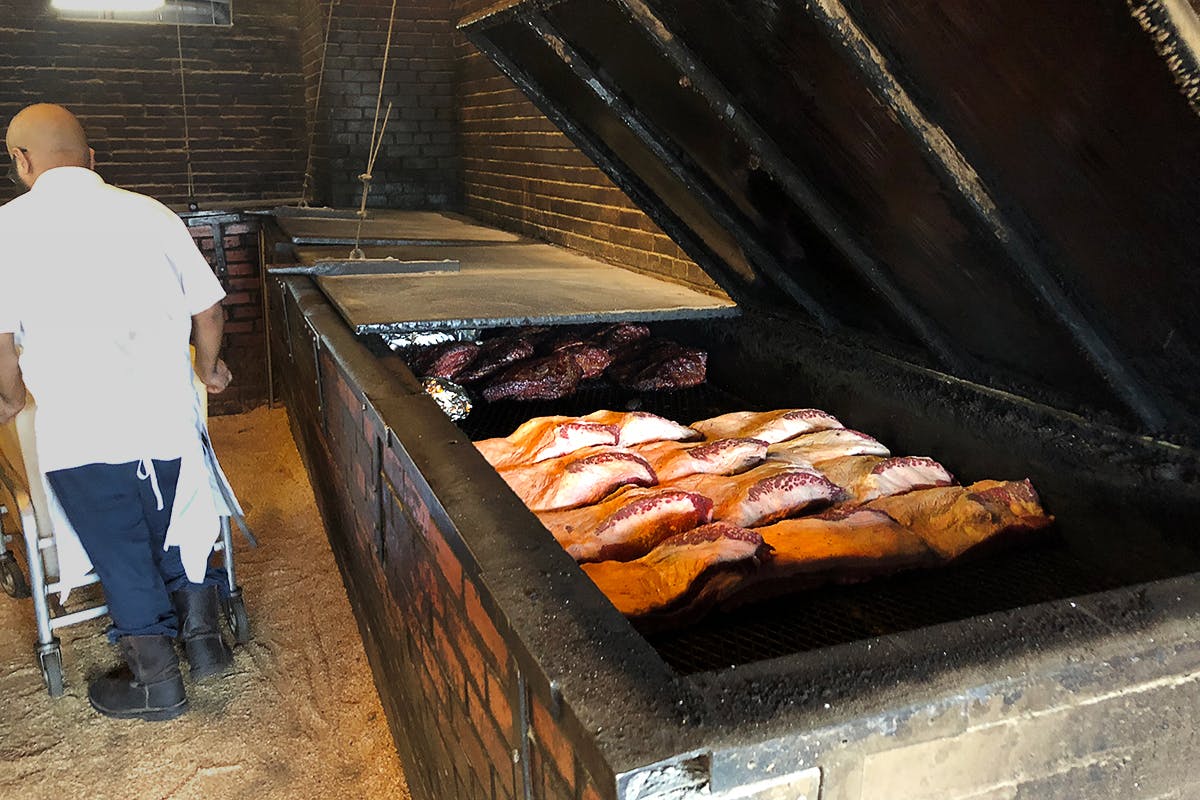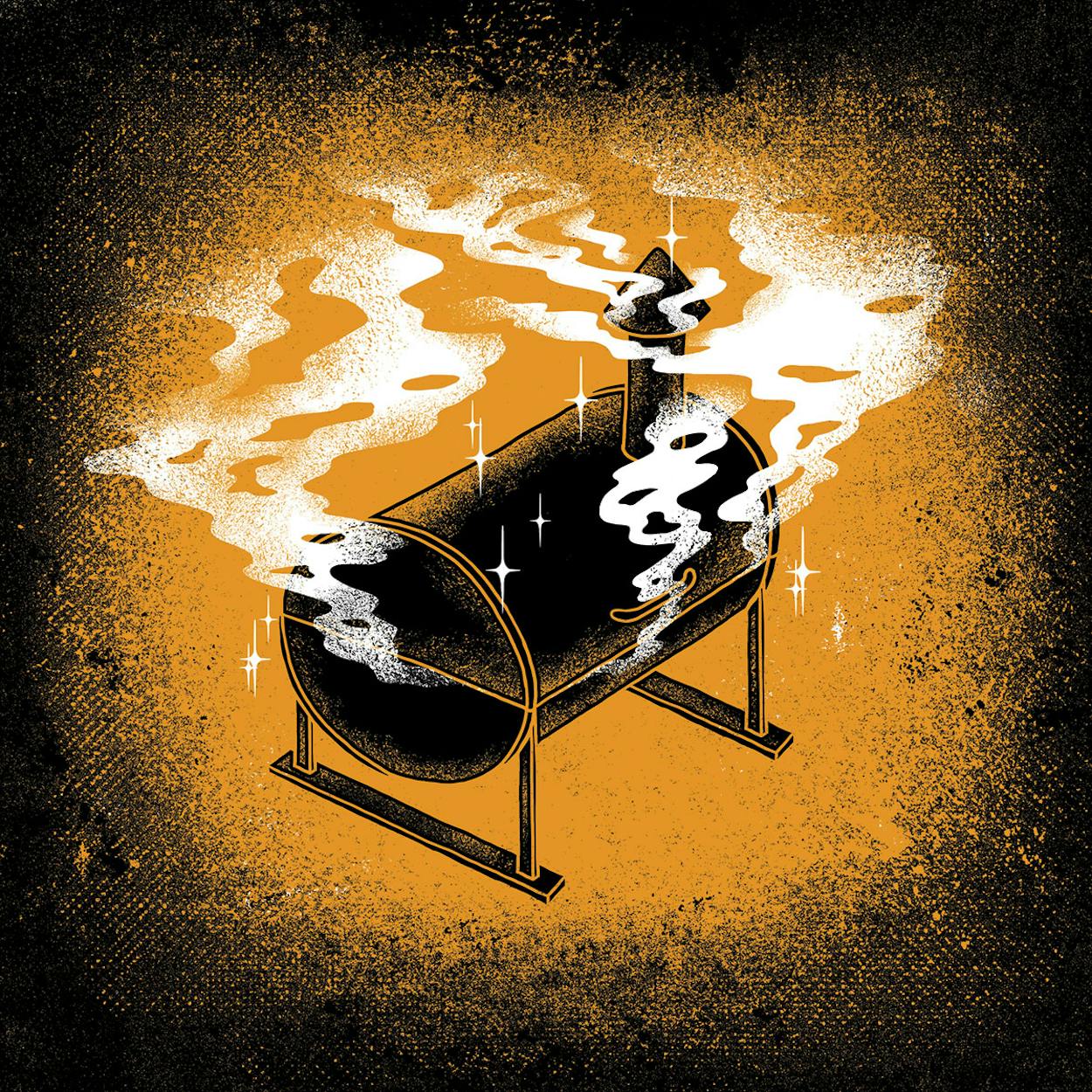I stood next to a steel smoker outside a small barbecue joint several years back while watching a pitmaster retrieve the meats I’d just ordered. He opened a door on a smoking cabinet to fetch the sausage. A layer of black grease so thick that it sagged was coating the inside of the door. It was the sort of ooze I picture when imagining the tar pits where fossilized dinosaur remains are discovered. I commented on the sludge, and the pitmaster smiled with pride. “That’s seasoning,” he told me before handing over a tray of memorably bad barbecue.
“Seasoning” is a term that gets thrown around in barbecue conversations as often as “falling-off-the-bone.” Barbecue fans sometimes attribute the quality, and even the flavor, of the smoked meats they’re eating to the seasoning of a joint’s pit. It can be like shorthand for saying the place has been around for a long while and the pits are appropriately broken in. For many backyard cooks (and some professionals), the term is an excuse or a misguided defense for cooking in a filthy smoker. But what do pitmasters at some of Texas’s best barbecue joints mean when they refer to a “seasoned” smoker?
“It seems more like a myth,” Kris Manning of Smokey Joe’s Bar-B-Que in Dallas told me when I asked him if a dirty smoker made better barbecue than a clean one. “When I hear someone referring to their pit being seasoned, I’m taking it as they’re really acclimated to it, and they really know how to work it.” When Manning took over his father’s joint, he inherited an old brick smoker. Customers assumed the secret to the barbecue was in the seasoning of the smoker because it had been around so long, but they pressure-washed the inside of that smoker once or twice a week. “If you get too much grease, you have a fire,” Manning explained.
It’s not just grease that builds up. I talked with wood smoke savant Bill Karau at his home, where he has studied how to produce optimal wood smoke for cooking. He evangelizes about the virtues of pure, clean wood smoke the way a Baptist preacher champions teenage abstinence. He says a seasoned pit, one with layers of tarry deposits, is nothing to strive for. Karau describes that “seasoning” as, “the condensate of unburned wood smoke. It’s those long, tarry hydrocarbons that recondense on the nearest cold surface, which is either the inside of the pit or it’s the brisket that was in the pit.” Yum.
Before he passed away, I interviewed Rick Schmidt in 2014 about seasoning the smokers at Kreuz Market in Lockhart. He moved the business from its longtime location downtown (which is now Smitty’s) to a new building with new brick pits on the north edge of town. Doubters assumed the barbecue could never be the same because they wouldn’t be using the brick smokers built decades earlier at the original location. Schmidt laughed at the notion. “About eight or ten years is all we’d get out of them,” he said of those smokers at the old location. The many loads of barbecue took their toll, so they’d tear them down, replace the metal lining, and rebuild the pits, replacing cracked and broken bricks.
The new Kreuz Market opened twenty years ago. Rick’s son, current owner Keith Schmidt, said they don’t have to rebuild their brick pits any longer. “The brick is just a veneer,” he said. The smoker is really made up of the steel lid and thick, steel walls inside the brick. Schmidt said they scrape the pits down weekly to keep them clean. I asked him if he puts any stock in the idea of a seasoned smoker. “A lot of what people call a seasoned pit is a dirty pit,” he said. “Once you’ve kinda burned off the new car smell, that’s the seasoning part.”

For the newer smokers made from huge propane tanks, there’s a seasoning process that happens before they’re ever cooked on, similar to how a new cast-iron skillet is treated. Aaron Franklin starts by hosing the inside of a newly completed smoker with soapy water, “to get the kinda gassy propane smell and bits of metal out.” Then he sprays a mist of grapeseed oil on all the interior surfaces and the grate of the smoker before firing the pit up to 350 degrees for an hour so. After that, he says, “Clean off the grates, and then get cooking.” He said he once completed the final weld of a smoker an hour before he loaded briskets onto it. So don’t let anyone say you can’t produce good barbecue from a new smoker.
“The first briskets we cooked on our Moberg were unbelievable,” Jordan Wright of Wright’s Barbecue in Fayetteville, Arkansas, said of his Texas-built steel smoker. He credits wood smoke from a clean fire for the flavor on his briskets, not the buildup of creosote and oils on the cooking surface. “If you have too dirty of a smoker, you’re talking about losing product all the time because of grease fires,” he said.
Michael Hernandez knows about losing money because of a dirty smoker. When he first bought Hays County Bar-B-Que in San Marcos, he inherited a smoker that hadn’t been well maintained. Hernandez was cooking for a catering job, and none of the meat was getting done. He built the fire as big as he could. “The fire box was bright red,” he remembered, but it didn’t matter. The exhaust stack was blocked. “At the elbow, it was completely clogged with soot,” he said. He was forced to cancel the catering job and close for the day. Since then, keeping a clean fleet of smokers has been a priority, not so much making sure they’re well seasoned.

“I personally have never seen the benefit of actually seasoning the pit,” Hernandez said. He uses peanut oil from a pressure sprayer to coat the interior of his new smokers. Then, he says, “I get the temperature up to 400 or 450, and let them burn for a couple hours like that.” When we talked, he said he thought he was in the minority of pitmasters when it came to thinking of seasoning as a myth. “I didn’t want to say anything because I know that so many people would frown if they heard that it didn’t matter,” he said.
That got me thinking that instead of surrendering the word “seasoned” to filthy smokers, let’s reclaim it. Just like a coveted, heirloom cast-iron pan with a layer of precious seasoning, a clean, well-oiled smoker is a glorious thing to cook on. You can fry up a good batch of pork chops on a new cast-iron pan just like you can get a good rack of ribs out of a brand new smoker. Neither work any better if they never get cleaned.
It’s not that smoking batch after batch of barbecue on your smoker isn’t useful in improving the barbecue that comes out of it. “You can cook great food on a brand new pit if you pay attention to it,” Aaron Franklin said, but he added that the quality of the barbecue improves after repeated use. “The cooker gets softer in its airflow, but I also think you learn how to cook on it through that process,” he said. I shared an analogy I came up with through all my conversations about seasoning. If you get your sixteen-year-old a new car, and two years later she can drive that car better than when she started, it’s not because the car is any different. Your kid just learned how to drive. Franklin agreed, saying, “Maybe it’s the cook that becomes seasoned and not the cooker.”
- More About:
- Aaron Franklin









